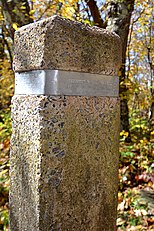Tuscarora Trail
| Tuscarora Trail | |
|---|---|
 The southern terminus of the Tuscarora Trail at Shenandoah National Park. | |
| Length | 252 mi (406 km) |
| Location | Eastern United States |
| Trailheads | South:Appalachian TrailinShenandoah National ParkinVirginia 38°17′34″N78°40′45″W/ 38.29278°N 78.67917°W North:Appalachian TrailnearHarrisburg, Pennsylvania 40°17′39.9″N77°5′26.9″W/ 40.294417°N 77.090806°W |
| Use | Hiking |
| Highest point | Southern trailhead,Shenandoah National Park,3,440 ft (1,050 m) |
| Lowest point | Potomac River,C&O Canal National Historical Park,380 ft (120 m) |
| Difficulty | Strenuous |
| Hazards | Severe weather, uneven and wet terrain, rattlesnakes, mosquitoes, ticks, black bears |
| Website | hikethetuscarora.org |
TheTuscarora Trailis a 252-mile (406 km)hiking trailin the eastern United States, following theAppalachian Mountainsthrough portions ofVirginia,West Virginia,Maryland,andPennsylvania.Its route is roughly parallel to, and to the west of, theAppalachian Trail.[1]
History[edit]
The Tuscarora Trail was originally conceived as an alternate route for theAppalachian Trail,which had been built in the 1920s-30s. By the 1960s, and before it was protected as aNational Scenic Trail,[2]a number of segments of the Appalachian Trail were being encroached upon and sometimes closed by private and commercial landowners. To ensure the trail's continuity, theAppalachian Trail Conservancybegan to consider alternate routes that could be used to bypass those threatened segments of the AT, with the goal of avoiding high-demand areas and maximizingpublic landusage.[3]
The alternate route was originally built in the late 1960s as two separate trails: the 142-mile Big Blue Trail in Virginia and West Virginia, and the 110-mile Tuscarora Trail in Maryland and Pennsylvania, which were separated by an unofficial crossing of thePotomac River.[4][5]By 1997, a crossing of the river via a road bridge had been approved, and the two trails were combined to form a continuous 252-mile route known as the Tuscarora Trail,[3]because it largely traverses ridgetops above theTuscarora Sandstoneformation.[6]
During the 1980s, several segments of the Tuscarora Trail in Pennsylvania had to be closed due to damage fromgypsy mothinfestations.[7]After several years of rehabilitation, those segments were reopened.[5]In the early 2000s, the Tuscarora Trail was named as a component of theGreat Eastern Trail,which will extend for more than 2,000 miles from Florida to New York.[8]A loop consisting of the Tuscarora Trail and the Appalachian Trail between their two junctions has been dubbed the Tuscalachian Loop, which is 435 miles in length.[7]
Route[edit]
The southern terminus of the Tuscarora Trail is at a junction with the Appalachian Trail inShenandoah National Parkin Virginia, on top ofBlue Ridge.Traveling northbound, the Tuscarora Trail diverges from the AT to the northwest and traversesMassanutten MountainandGreat North Mountainthrough Virginia for about its first 106 miles.[6]North of the town ofSiler,the trail passes into West Virginia and for about the next 37 miles crosses that state'sEastern Panhandleregion. The trail crosses thePotomac Rivervia the road bridge forUS Route 522,and enters Maryland atHancock.[9]
The trail then shares its route with theC&O Canal Towpathfor about eight miles, then heads north for about six additional miles in Maryland. It then crosses theMason Dixon Lineand spends the next 95 miles in Pennsylvania, traversingTuscarora MountainthenBlue Mountain.[6]The northern terminus of the Tuscarora Trail is at another junction with the Appalachian Trail, plus theDarlington Trail,on Blue Mountain about 10 miles north ofHarrisburg.[10]
For planning purposes, the Tuscarora Trail is divided into 22 sections, ranging from 6 to 18 miles in length, with section names displayed prominently in guidebooks and on some trail signs.[11]

References[edit]
- ^Lupp, Thomas; Brown, Pete (2013).The Tuscarora Trail: A Guide to the North Half in Maryland and Pennsylvania(5th ed.). Vienna, Virginia: The Potomac Appalachian Trail Club. p. 1.ISBN978-0-915746-73-6.
- ^Seaborg, Eric (July/August 1984), "The Road Less Traveled".National Parks.58(7/8):34–35
- ^abCramer, Ben, ed. (2008).Pennsylvania Hiking Trails(13th ed.). Mechanicsburg, Pennsylvania: Stackpole Books. p. 3-4.ISBN9780811734776.
- ^"Tuscarora Trail".Potomac Appalachian Trail Club.RetrievedMarch 29,2014.
- ^abLupp and Brown, p. 2-4
- ^abcLupp and Brown, p. 1-2
- ^abMitchell, Jeff (2005).Backpacking Pennsylvania: 37 Great Hikes.Mechanicsburg, Pennsylvania: Stackpole Books. p. 82.ISBN0811731804.
- ^"Maps & Trail Descriptions - Great Eastern Trail".www.greateasterntrail.net.May 20, 2014.RetrievedApril 14,2018.
- ^"Tuscarora Trail".Potomac Appalachian Trail Club.RetrievedFebruary 20,2022.
- ^Lupp and Brown, p. 27-93
- ^ "Hike the Tuscarora".The Potomac Appalachian Trail Club. 2017.RetrievedOctober 16,2020.
